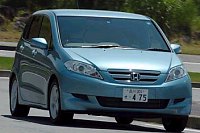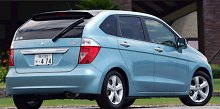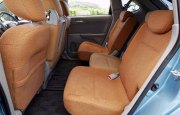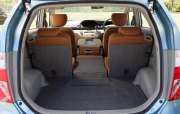|
 Compact
people carriers - usually referred as MAV (Multi-Activity Vehicles) -
used
to be a compromise between size and accommodation. To carry more people
than ordinary family cars, they employ 3 rows of seats. Because of
limited
length, the last row is usually too cramped for adults. Simultaneously,
luggage space is eaten by the third row. Renault Scenic solved this by
offering a long-wheelbase version, but it adds cost and deteriorates
agility. Compact
people carriers - usually referred as MAV (Multi-Activity Vehicles) -
used
to be a compromise between size and accommodation. To carry more people
than ordinary family cars, they employ 3 rows of seats. Because of
limited
length, the last row is usually too cramped for adults. Simultaneously,
luggage space is eaten by the third row. Renault Scenic solved this by
offering a long-wheelbase version, but it adds cost and deteriorates
agility.
6
years ago, Fiat
Multipla
demonstrated a clever solution - by using an extra-wide body, its cabin
can accommodate 2 rows of 3 seats for a total of 6-people
accommodation.
All passengers share abundance of legroom while leaving a lot of
luggage
space behind. Moreover, the short and wide profile, like sports cars,
actually
improve handling, limiting body roll (usually a problem for people
carriers)
while maintaining agility in cornering.
Strangely,
in the
following
6 years the Multipla revolution did not propagate to other cars in the
class. They wanted to, but they couldn't. While the Multipla was built
on a dedicated spaceframe platform, its rivals were derived from
mainstream
hatchbacks such as Megane and Golf. These monocoque platforms are
difficult
to stretch 100mm or so in width, as this would have created too many
hurdles
to overcome in engineering and production process.
In
year 2004,
Honda finally
launched a car following the format of Fiat Multipla. Why Honda? to me,
it is nothing surprising. Honda's production method has been seen as
the
most flexible in the world. It can produce Civic and CR-V, Accord and
MD-X
in the same production lines. It can enlarge the Japanese Accord to
American
Accord - a full size up. So why not do the same to the Civic
platform?
 This
car is called Edix in Japan or FR-V (stands for Flexible Recreation
Vehicle)
in Europe. It is derived from CR-V, which in turn based on the Civic
platform.
Compare with the European 5-door Civic hatchback, its body has been
widened
by 110mm. It is also much taller (at 1610mm) to enable a higher sitting
position and more headroom. In contrast, length and wheelbase are
exactly
the same as the Civic hatchback. This
car is called Edix in Japan or FR-V (stands for Flexible Recreation
Vehicle)
in Europe. It is derived from CR-V, which in turn based on the Civic
platform.
Compare with the European 5-door Civic hatchback, its body has been
widened
by 110mm. It is also much taller (at 1610mm) to enable a higher sitting
position and more headroom. In contrast, length and wheelbase are
exactly
the same as the Civic hatchback.
The
Edix looks
sharp and
handsome. It does not have the funny or bulky shape of other MAV to
attract
female buyers. Instead, its aggressive and angular shape pleases men.
Its
rising shoulder line delivers a sense of sportiness while the high tail
has clear resemblance to BMW X5. To certain degree it looks like a SUV
fitted with smaller wheels.
Inside, the
highlight is
accommodation rather than style. A conventional dashboard might be
alright,
but the shinny hard plastics it employs is a let down by the standard
of
Honda. It looks no where as high-quality as Renault Scenic and Ford
C-Max.
Like
Fiat
Multipla, all seats
are independent and can slide back and forth to tailor the most
comfortable
sitting position for individuals. But unlike the Fiat, center seats are
narrower than others as they are designed for children, thus the outer
seats are benefited from extra width. This means when the car sits up
to
4 persons, they will enjoy better comfort. When it holds 6 adults, 2 of
them will suffer, unlike the case of Fiat. So whether it is more
sensible
than the Fiat depends on the frequency you need to sit 5 or 6 adults.
To
avoid passenger rubbing shoulders with the driver, the center front
seat
is positioned a few inches behind the driver seat, something like Smart
Fortwo.
  
The chassis
rides
on the
same suspensions as Civic - the front consists of MacPherson strut plus
a toe-control link, the rear is a double-wishbones-based multi-link
setup.
Edix handles quite good by MAV standard, combining good ride comfort
with
decent body control. Body roll is well contained in cornering, thanks
to
the extra-wide tracks and a high roll axis set into suspension
geometry.
The latter makes body roll less noticeable to the driver. Besides, it
uses
conventional hydraulic steering rather than the fuel and money saving
electric
assistance used in Civic, ensuring better communication with the road.
Power comes
from
2 existing
petrol engines - 1.7 VTEC with 130ps (125hp DIN) and 2.0 i-VTEC with
156ps
(150hp DIN). Both needs to rev hard in order to deliver acceptable
performance
and, unfortunately, they are noisy when doing so. A better choice is
reserved
for European market. FR-V is available with Accord's 2.2-litre
common-rail
turbo diesel engine, an engine highly praised as refined and frugal.
The
all-aluminum, 16-valve engine with variable geometry turbocharger
produces
140hp and a remarkable 251 lbft of torque, enabling the FR-V to cope
easily
with its 1.5-ton body. It is undoubtedly pick of the range.
|